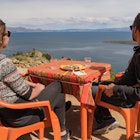

Choose the right time for your travels to Bolivia with this seasonal guide © Curioso.Photography / Shutterstock
From towering mountains and semi-arid forests to serene salt flats, from the jungles of the Amazon to some of the highest cities in the world, Bolivia has a lot to offer – and the weather patterns to match.
The climate here changes according to the region and the time of year, and there is a wet season and dry season to consider before booking any tickets.
Without the massive tourist numbers of its neighbors, Bolivia does not see major shifts in prices from one season to the next, though you'll pay slightly more during local holidays and big festivals. Even when there are hikes in rates, locals are often open to negotiating on prices.
Whether you are here for hiking in the Andes, taking selfies on the salt flats or chilling out in the world's highest capital city, here's a seasonal guide to what's happening in Bolivia.

May to October is the best time to experience Bolivia's outdoors
Bolivia’s dry season runs from May to October, mostly falling during the southern hemisphere winter. This is the perfect time for hiking and other outdoor pursuits, especially in the Andean zone, though the highlands will be cold and overnight temperatures can drop below –15°C (5°F) at altitude.
In the lowlands, the weather is still warm and it's less humid than it is over the rest of the year, with a lower chance of torrential rain and all the associated travel disruption. But watch out: there's a chance of surazos, polar winds that come from the south and can drop the temperatures below freezing for three or four days at a time. These become more frequent in July, when it really feels like winter.
August is the most crowded month of the year in Bolivia – Bolivia’s Independence Day falls on August 6 – so expect to see heavy demand for hotels and tourist services and a small hike in prices. The weather is still cold but there is a smaller chance of sudden drops in temperature or rain. The lowlands can get windy too.
September is the perfect time to travel around the Amazon and the cities of the lowlands. The weather is not as hot and humid as in the Bolivian summer and the lack of mosquitos is a plus for outdoor activities.
The first signs of spring show up as trees burst into bloom, and in October, temperatures start to go up all over the country. This is when tourism slows down a bit and visitors have a good chance of negotiating prices and getting better deals.

December to March is the best time for culture and salt flat views
Bolivia's wet season has its own magic. With a fresh dose of rain, the valleys shine with all their natural splendor and travelers can swim, raft and kayak in crystal clear rivers swelled by the increased rainfall.
This is a great time to head north, where the flooded Uyuni salt flats present a mirror to the sky. Just make sure you are flexible with your timings in case there is any disruption to transportation due to flooding – January and February are the rainiest months and road closures are common.
This is also the prime time for a cultural journey, with a packed calendar of events. In December, Christmas festivities spill over into New Year parties across the country.
La Paz hosts Alasitas, one of its biggest festivals, in January, when locals shop for miniature items to offer as gifts to honor the Andean god, Ekeko. February in Oruro is dominated by Carnaval celebrations and March is harvest season in Tarija, Bolivia's main wine-growing region.

April and November have the best weather for traveling across the country
Sunny days, cool nights and a general lack of rain make for a great combination in the shoulder-season months of April and November. This is the ideal time of year if you plan to visit a number of different regions across Bolivia, with good sightseeing weather at either end of the dry season.
In addition, April hosts Easter-related events in many places around the country and November brings one of the most interesting cultural events of the year: the Day of the Dead weaves a spell that will entice anyone with an interest in local traditions.
It's one of Bolivia's most colorful and symbolic occasions, celebrated all over the country with visits to cemeteries to honor dead relatives. A week later, some regions celebrate the Ñatitas festival for all the dead who were forgotten. With warm weather in the mix, November is a great month to plan a cultural trip to Bolivia.
Explore related stories





 Budget TravelBolivia on a budget: see world-class sights for fewer bolivianos
Budget TravelBolivia on a budget: see world-class sights for fewer bolivianosNov 6, 2023 • 8 min read


 AstrotourismA stargazer’s guide to the Atacama Desert: find the Milky Way with these top tips
AstrotourismA stargazer’s guide to the Atacama Desert: find the Milky Way with these top tipsJan 8, 2022 • 6 min read
 Solo Travel10 top spots for solo travelers in winter (or any other time of year)
Solo Travel10 top spots for solo travelers in winter (or any other time of year)Dec 10, 2021 • 10 min read

